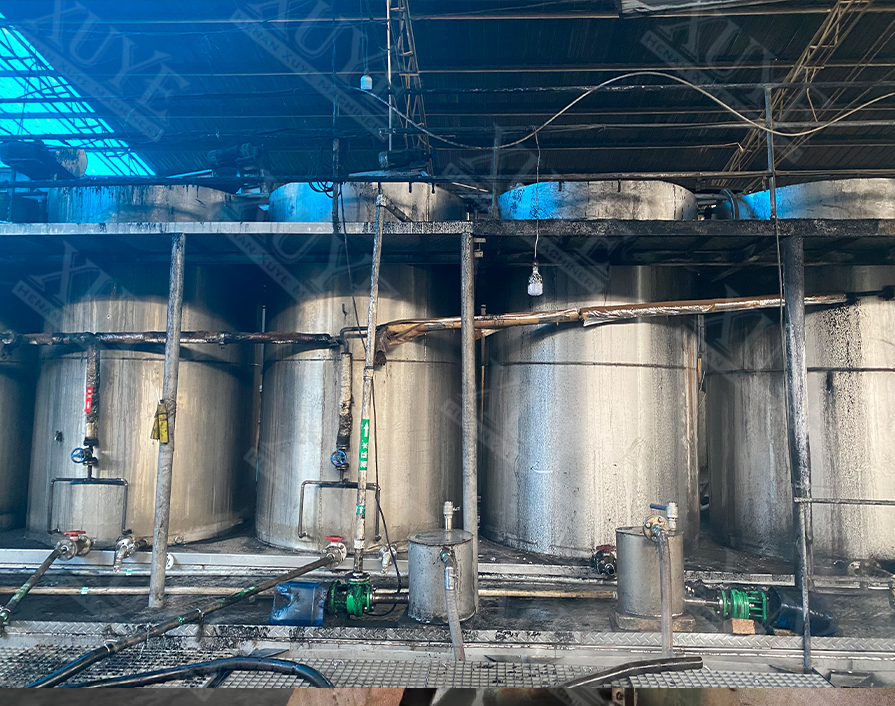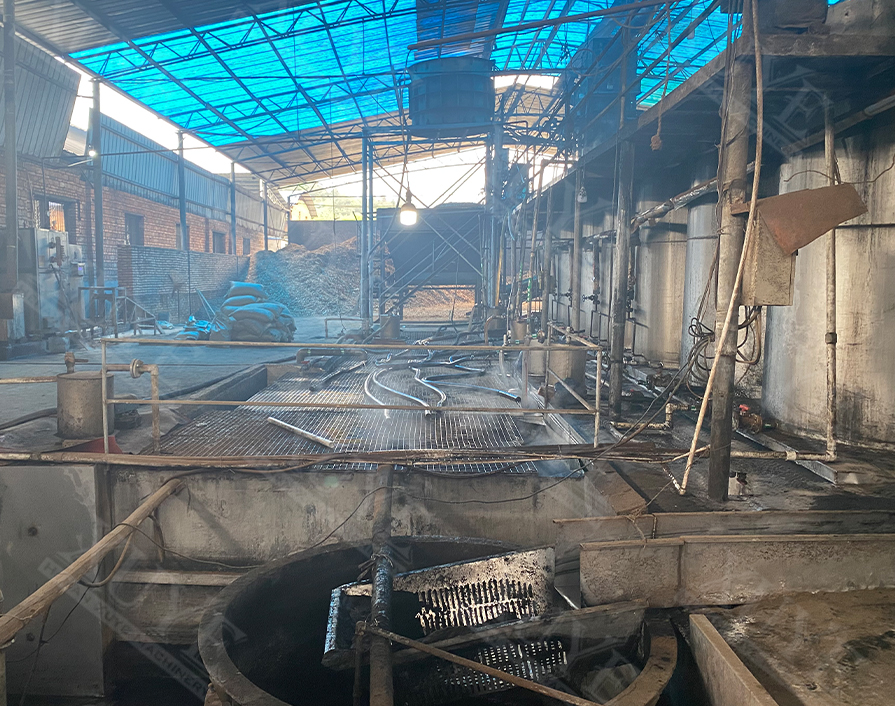BRIEF INTRODUCTION
Chemical method is a common method for producing activated carbon, which has high activation effect and low production cost. Phosphoric acid, as a chemical activator, plays a key role in the production of activated carbon, which can significantly improve the pore structure and surface area of carbon, thereby enhancing its adsorption performance.
PROCESS
The raw material is crushed into sawdust ≤ 4mm. Then it enters the dryer to dry the moisture to 10-15%. The dried sawdust is screened to screen out particles > 4mm.
The raw material and phosphoric acid are mixed and stirred in the specified ratio. The sawdust has a large specific surface area and can be moistened in a short time.
The mixed material is sent to the activation furnace. The material goes through the following stages.
Low temperature stage (100–200°C): phosphoric acid dehydration and initial carbonization of the raw material.
High temperature stage (400–600°C, usually 450–550°C): phosphoric acid catalyzes oxidation reaction to form microporous and mesoporous structures. The activated carbon after activation enters the washing tank for water washing to clean the phosphoric acid in the activated carbon.
Phosphoric acid undergoes the following changes during the whole process:
Low temperature stage (100–200°C): dehydration and esterification Physical changes:
Liquid phosphoric acid (H₃ PO₄) penetrates into the raw material (such as sawdust) and is evenly distributed through capillary action.
Water gradually evaporates, the concentration of phosphoric acid increases, and a viscous liquid film is formed to wrap the cellulose fibers.
Chemical changes:
Dehydration reaction: Phosphoric acid releases H⁺, which reacts with the hydroxyl group (-OH) in cellulose to form phosphate ester (cellulose-OPO₃ H₂)
and removes water:
Cellulose-OH + H₃ PO₄ → Cellulose-OPO₃ H₂ + H₂O Cellulose-OH + H₃ PO₄ → Cellulose-OPO₃ H₂ + H₂O
Ester bond formation: destroys the crystalline structure of cellulose, making it easier to pyrolyze, and fixes the carbon skeleton through cross-linking to prevent excessive shrinkage.
Medium temperature stage (200–400°C): decomposition and cross-linking Physical changes: Phosphoric acid is partially dehydrated to form condensed acids such as pyrophosphoric acid (H₄ P₂O₇) and polyphosphoric acid (H₅ P₃O1₀). The raw materials begin to carbonize, and volatile organic matter (such as tar) is inhibited by phosphoric acid, reducing pore blockage. Chemical changes: Acid-catalyzed cracking: Phosphoric acid accelerates the pyrolysis of cellulose and lignin, generating CO, CO₂ and small molecular organic matter to form initial pores. Cross-linking stability: Phosphoric acid forms P-O-C bonds with the carbon skeleton, enhancing the mechanical strength of the carbon structure and preventing pore collapse at high temperatures. 3. High temperature activation stage (400–600°C): oxidation and pore formation Physical changes: Phosphoric acid is further dehydrated and partially converted into metaphosphoric acid (HPO₃) and phosphorus oxides (such as P₂O₅). The carbon skeleton is etched by phosphoric acid, and a large number of micropores and mesoporous structures are generated.
Chemical changes:
Oxidation reaction: Phosphoric acid acts as an oxidant to promote the oxidation of carbon to generate CO₂ and expand the pores:
C + H₃ PO₄ → CO₂↑ + H₂O + phosphate C + H₃ PO₄ → CO₂↑ + H₂O + phosphate
Template effect: Phosphoric acid and its condensation products occupy space during the carbonization process, leaving pores after washing (similar to “sacrificial template”).
Cooling and washing stage: residue and recovery Phosphoric acid residue:
Undecomposed phosphoric acid remains in the activated carbon pores in the form of H₃ PO₄ or phosphate (such as K₃ PO₄, Na₃PO₄).
Acid recovery:
Phosphoric acid is recovered by water washing (the recovery rate can reach more than 80%).
Finished activated carbon can be added to screening equipment, crushing and grinding equipment according to the customer’s particle size requirements to reach the customer’s finished product size requirements and then enter the packaging machine for packaging.
Phosphoric acid etching forms developed micropores (<2nm) and mesopores (2-50nm), which are particularly suitable for liquid phase adsorption (such as decolorization, water treatment).
By adjusting the phosphoric acid concentration, impregnation ratio and activation temperature, the pore size distribution can be directional controlled (for example, high concentration
phosphoric acid is more likely to generate mesopores).
Click to expand all
With advanced technology and reliable products, we provide efficient purification and green environmental protection solutions to many customers.


Xuye and I are working together to innovate. Activated carbon and biochar will help you improve your environmental protection business.

Xuye and I are working together to innovate. Activated carbon and biochar will help you improve your environmental protection business.

Xuye and I are working together to innovate. Activated carbon and biochar will help you improve your environmental protection business.

Xuye and I are working together to innovate. Activated carbon and biochar will help you improve your environmental protection business.






Xuye and I are working together to innovate. Activated carbon and biochar will help you improve your environmental protection business.

Xuye and I are working together to innovate. Activated carbon and biochar will help you improve your environmental protection business.

Xuye and I are working together to innovate. Activated carbon and biochar will help you improve your environmental protection business.

Xuye and I are working together to innovate. Activated carbon and biochar will help you improve your environmental protection business.






Xuye and I are working together to innovate. Activated carbon and biochar will help you improve your environmental protection business.

Xuye and I are working together to innovate. Activated carbon and biochar will help you improve your environmental protection business.

Xuye and I are working together to innovate. Activated carbon and biochar will help you improve your environmental protection business.

Xuye and I are working together to innovate. Activated carbon and biochar will help you improve your environmental protection business.






Xuye and I are working together to innovate. Activated carbon and biochar will help you improve your environmental protection business.

Xuye and I are working together to innovate. Activated carbon and biochar will help you improve your environmental protection business.

Xuye and I are working together to innovate. Activated carbon and biochar will help you improve your environmental protection business.

Xuye and I are working together to innovate. Activated carbon and biochar will help you improve your environmental protection business.






Xuye and I are working together to innovate. Activated carbon and biochar will help you improve your environmental protection business.

Xuye and I are working together to innovate. Activated carbon and biochar will help you improve your environmental protection business.

Xuye and I are working together to innovate. Activated carbon and biochar will help you improve your environmental protection business.

Xuye and I are working together to innovate. Activated carbon and biochar will help you improve your environmental protection business.






Xuye and I are working together to innovate. Activated carbon and biochar will help you improve your environmental protection business.

Xuye and I are working together to innovate. Activated carbon and biochar will help you improve your environmental protection business.

Xuye and I are working together to innovate. Activated carbon and biochar will help you improve your environmental protection business.

Xuye and I are working together to innovate. Activated carbon and biochar will help you improve your environmental protection business.






Xuye and I are working together to innovate. Activated carbon and biochar will help you improve your environmental protection business.

Xuye and I are working together to innovate. Activated carbon and biochar will help you improve your environmental protection business.

Xuye and I are working together to innovate. Activated carbon and biochar will help you improve your environmental protection business.

Xuye and I are working together to innovate. Activated carbon and biochar will help you improve your environmental protection business.




This website uses cookies to improve your browsing experience. By continuing to use this site, you accept the use of our cookies. Data collected from this website is processed and stored in the United States.




